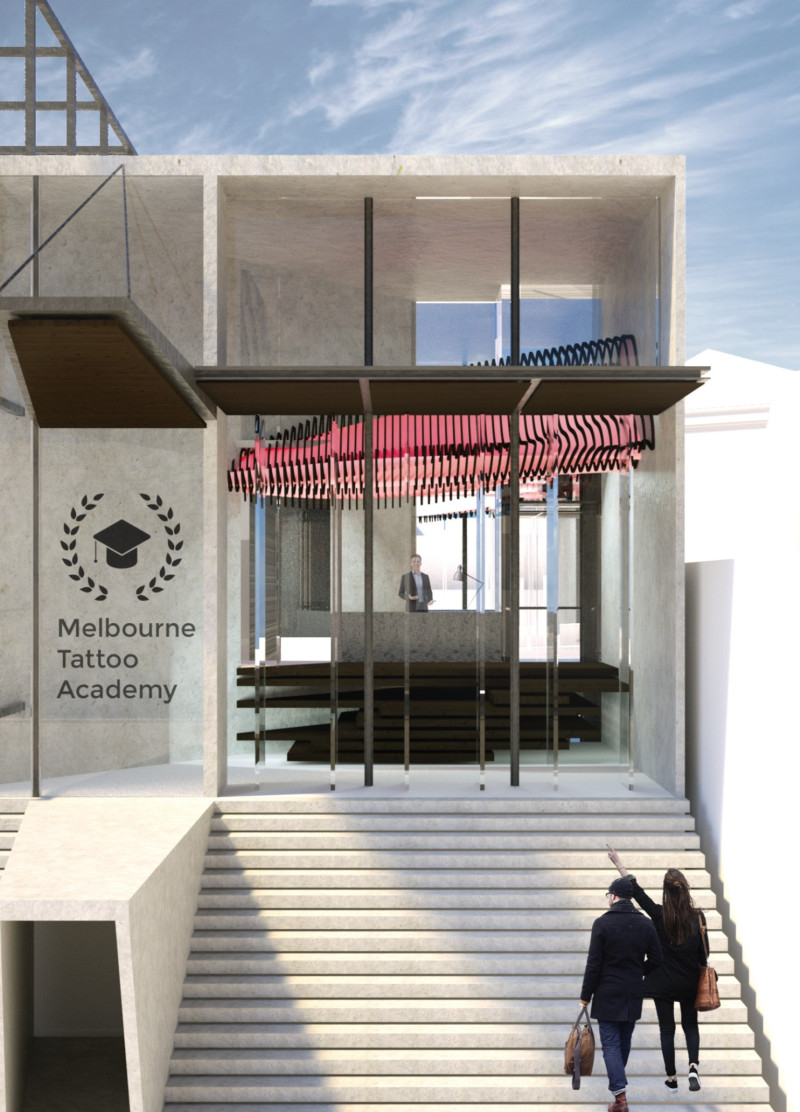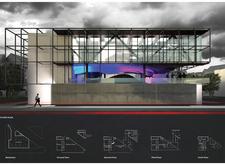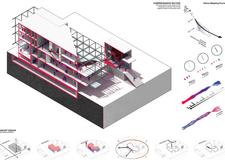5 key facts about this project
The Melbourne Tattoo Academy represents a response to the evolving discourse surrounding tattoos in contemporary society. Its function extends beyond that of a traditional educational institution; it is a cultural space that bridges the gap between the public and the tattoo community. By providing a welcoming environment, the academy encourages open dialogue, interaction, and understanding, aiming to dispel preconceived notions that often accompany the tattoo profession.
The architectural design emphasizes accessibility and engagement as foundational principles. Upon approach, the building features a robust concrete base that grounds the structure while creating a sense of solidity. The use of generous glass facades allows natural light to permeate the interior, establishing a strong visual connection with the urban surroundings. This transparency promotes the idea of openness, inviting both the public and potential students to explore the academy's facilities.
Inside, the spatial organization is thoughtfully articulated to facilitate different functions. Central to the layout is a multi-functional common area designed to serve as a café, workshop space, and gathering point for social interaction. This flexible environment is pivotal in creating a communal atmosphere, encouraging collaboration among students and fostering creative exchange. The common area acts as a hub, where ideas are generated and artistic expressions flourish.
Workshop spaces are strategically designed to accommodate hands-on learning experiences, allowing students to engage directly with the craft of tattooing. These areas are equipped with the necessary tools and resources, creating an environment that prioritizes practical skill development. In addition, dedicated exhibition spaces provide opportunities for students and guest artists to showcase their work, reinforcing the academy's commitment to celebrating tattoo art as an integral cultural form.
The unique design of the Melbourne Tattoo Academy lies in its harmonious blend of architecture and functionality. The façade's combination of concrete, glass, and steel not only serves structural purposes but also conveys a narrative of transformation — from stigma to acceptance. By opting for materials that signal both strength and transparency, the design reflects the very values the academy stands for. The interiors are complemented by vibrant textile elements, which infuse warmth into the space and create a welcoming atmosphere, contrasting with the industrial nature of the exterior.
This project also underscores the importance of sustainability, as it incorporates design strategies aimed at reducing environmental impact. By maximizing the use of natural light and integrating green spaces wherever possible, the architecture promotes a connection to nature that enhances the overall experience for users.
The design of the Melbourne Tattoo Academy presents an opportunity to actively engage with the tattoo community and contribute to the ongoing conversation surrounding its legitimacy in the broader cultural landscape. By exploring architectural designs, sections, and plans of the project, one can gain deeper insights into the thought processes that informed its development. Readers are encouraged to delve into the presentation of this unique architectural endeavor, as it exemplifies how design can play a crucial role in fostering community cohesion and challenging societal norms surrounding tattoo culture.


























